The emergence of new information has allowed me to solve a huge puzzle, when this car turned up in a pumpkin warehouse in 2009, in a sorry state. Now, fully restored, it will be on display at the Pebble Beach Concours d'Elegance at the end of the month. In the end, the legend turned out to be true, there was only one 507 Roadster in Elvis' hands. It left the factory in white, was red most of its life, and has been white again.
You may have read this story in another post, but I'm going to expand on it beyond the information BMW supplied about it. That's when all the pieces of the puzzle fit together. The history of this two-seater has been very intense, and deserves to be dusted off. On the other hand, this article has a purpose of amendment, I already did another one about it in 2014 that was missing many details, go ahead my apology. Here we go.
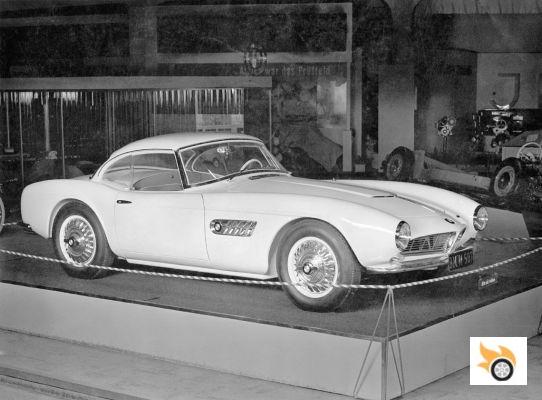
The beginnings of the 507 Roadster
The BMW 507 Roadster was conceived as the replacement for the 328 Roadster back in 1946, but the engineering work didn't start until 1953, remember that the whole of Germany was in tatters after World War II and continuous Allied bombing harassment since the early 1940s. It was intended to be a car that could sell well in the United States, with an initial sales target of 1,000 units per year. The American importer, Hoffman, wanted 2,000 units at a price of 12,000 marks each.
Its top speed, 225 km/h, was an outrage for the time. That was with the "proper" development, although it reached 207 km/h as standard. At that time the cars were braked with drums, although the last units were equipped with front disc brakes. Costs soared due to the use of aluminum bodywork, and although it was proposed to make it integral in steel, it never happened. The high price only put it within the reach of the wealthiest, both in Europe and the United States, and its export was quite limited.
It is a two-seater convertible, which had a hardtop for when the weather was bad, otherwise it had a folding canvas top.
The production of this model began in 1955, when they leave the factory the first copies, #70002 and #70003. It was premiered in society at the Frankfurt Motor Show that year, with the presence of Alain Delon, Ursula Andress and John Surtees. Both units were exhibited (one of them in the image above), although the car was still a little bit to be completely baked. Series production as such begins on December 11, 1956 with chassis number #70005.
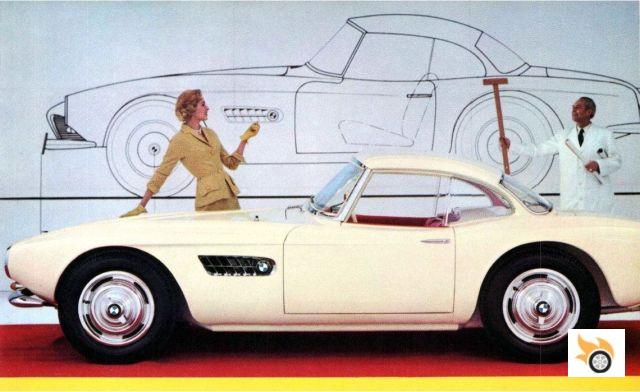
BMW had some industrial problems with this model.
The specific unit of which this article is about left the assembly line on September 13, 1957 and received the registration number M-JX 800. Two years after the official unveiling, this car was also in Frankfurt and was used as a press car. Auto motor und sport used it for a comparison with a Mercedes 300 SL, which swept it in acceleration. Autocar also tasted it, and Road & Track said it was worth paying what they were asking for it. In October 1957, driver Hans Stuck exhibited it at the London Motor Show. After the London show he drove it to the Turin Motor Show, previously stopping in Belgium to present it to King Baudouin.
During the following year, this car was used in competition by the German driver, who was known as the hill climb champion in multiple races in Germany, Austria and Switzerland. In the summer of '58 it won a beauty contest in Wiesbaden, and had a role - together with another 507 - in the Bavaria Filmstudios musical film "Hula-Hopp Conny" or "Conny og jazzklubben", starring Cornelia Froboess and Rudolf Vogel (they don't even know this on IMDB). The film was released in West Germany on 5 March 1959.
In August 1958 it received major changes to the engine, either rebuilt or completely new. It was also repaired the bumper, the windshield (in fact it was repaired twice) and the gearbox. It was being prepared for its return to "civilian life", after having been used in several competitions and as a demo unit for BMW. By the end of November 1958 it was in excellent mechanical condition. 65 units were produced in white, and although it was supposed to have red upholstery, it left the factory with black leather. Another item of equipment was a Becker Mexico radio with an automatically extendable antenna.
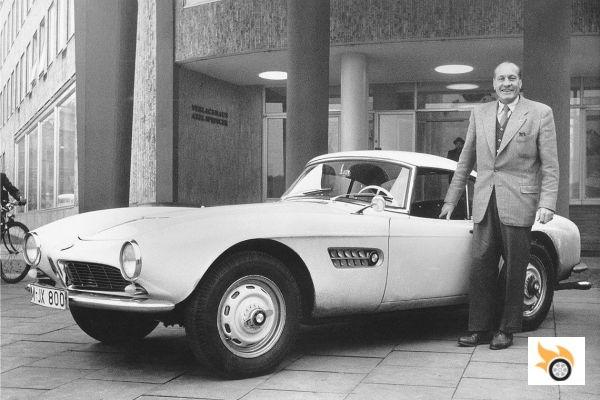
Elvis enters the building... and meets him
On 12 December it ended up at Autohaus Wirth, a dealership in Frankfurt, and received another registration number, F 04071. In less than a month it was tasted by an American serviceman serving in the area, one Elvis Aaron Presley, who was already famous at the age of 23. It was used as a selling point that it was a used 507 Roadster in the best possible condition. The delivery to the American star was on December 21, 1958, in a social event that many journalists witnessed. A few days later the car began to wear its third license plate, A-1499, typical of the occupation forces of the US Army in the FRG.
Some sources said it was a leasing deal, but it was a normal purchase transaction. Elvis wanted a Porsche 550 Spyder, but this 507 Roadster was available on the spot. He used it to drive from Bad Nauheim, where he was living on lease, to the American Ray Barracks base in Friedberg. Although Elvis already had some fame, he did not benefit from any privileges during his time in the army, he simply had his residence outside the base, where he served with the 3rd Armored Division, which was active from 1941 to 1996. The base was decommissioned in 2007, well after the end of the Cold War.
The car remained white until August 1959, when the car was painted red for practical reasons.
Presley's fans were in the habit of dedicating affectionate messages to him with lipstick on the car's bodywork, which was difficult to erase. Not that Elvis disliked that as a singer, but as a military man who used that car to go to work. The license plate also changed that year, receiving the plate G-1620. This confused many people, including yours truly, who thought it was another 507 Roadster. Military plates were renewed every year, every day you learn something new. There are pictures of the G-1620 in both white, and red, putting that mystery to rest. There was only one 507 Roadster, the protagonist of our story, and historically speaking it makes no sense to think of another chassis number.
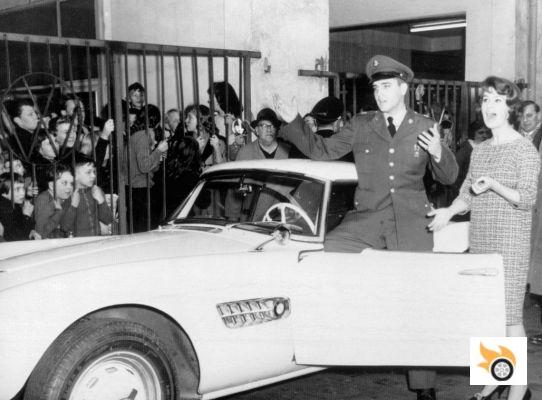
On March 2, 1960 Presley finished his service with the army and returned to the United States. There he was lost track of due to lack of documentation. It was believed to have ended up in the hands of actress Ursula Andress in 1963, which is not true. She had a 507 Roadster, but not this one, it was #70192 and was auctioned in 1997 by Barrett-Jackson for $350,000. Both Presley and Andress shared a cast in the movie "The Idol of Acapulco", which some of us old-timers around here know better from Florentino Fernandez's dubbing as "The Torpedo of Acapulco" and his popular song "Amatoma en Chiquitistán". I never thought I would end up relating an article about cars with "Tonight we cross the Mississippi"...
Actually, this car ended up at a Chrysler dealership in New York, where Elvis gave it in exchange for another car. Its next owner was an Alabama radio announcer, Tommy Charles, who bragged at the time about owning Elvis' car. It would pass as a fantasy, especially because it cost him very little money, $4,500 at the time; there wasn't that culture of hypervaluation that we have today. This owner swapped the original 150hp 3.2 V8 engine for a Chevrolet-sourced supercharged V8 for racing.
Fitting such a thing required major modifications to the engine bay. The original gearbox was blown out, as well as the rear axle.
Here we lose track of the original engine and gearbox, replaced by the original GM engine and a Borg-Warner gearbox. It also presumably lost the original dashboard at the time, as the American V8 engine needed its own instrumentation, and was reupholstered in red. Charles disposed of the car in 1963, which ended up in Arizona. One of its next owners may have been military, as it sported a front window sticker from Williams Air Force Base (Mesa, Arizona) dated 1967. There is no further evidence of this circumstance.
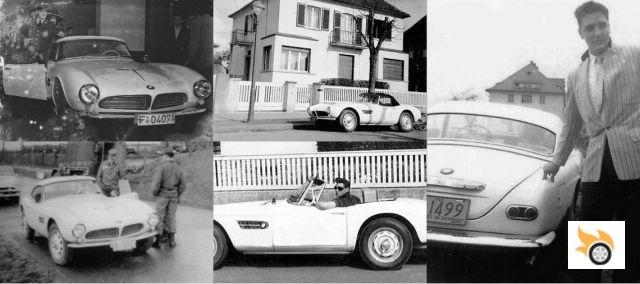

The new dashboard didn't clock a single mile, so its mileage is impossible to know.
Its next documented owner was an aerospace engineer, Jack Castor, who acquired the car with a V8 engine also of GM origin, naturally aspirated, so there is another engine change here. This change of hands took place in Arizona in 1968, where, incidentally, it received an oil change in October, at a Chevrolet dealership in Chandler. Castor bought the car from one Lloyd Cottle, an acquaintance of his who flew from Palo Alto, California to Arizona to bring it to him. Castor offered to pay for his return ticket as well in case he wasn't convinced by the car. Eventually he was convinced that it was the same car that Hans Stuck drove, but he wasn't sure it was Elvis' car.
Jack Castor was the last owner of the car. He had been to Germany in his youth, and had really liked the car, so he didn't hesitate when he saw it advertised in a Gilbert, Arizona newspaper. Castor used the car with that naturally aspirated Chevrolet V8 engine for about five or six years until he decided to leave it in its original condition, but the German 3.2 V8 was not easy to find. With no engine or gearbox, the car was stored for 35 years in a barn. It shared a room with another 507 (#70089, his brother's), a Triumph TR3, two Alfa Romeo Giulietta Spiders, a BMW 2600, a Jaguar E-Type Coupe, an Isetta, and a few others. Jack Castor regularly drove a Ferrari 250 GT California Spider, as well as a Jaguar D-Type replica and a Kaiser Traveler, among others. He liked Europeans, wow.
The car was presumed lost for years, until an article by Bimmer magazine journalist Jackie Jouret about it prompted Castor to send an email saying he had the chassis number. The journalist went to check out the find, and when she found the VIN her eyes glazed over. He had found THE BMW. He wrote another article for Bimmer that appeared in 2009, five years before the restoration process began.
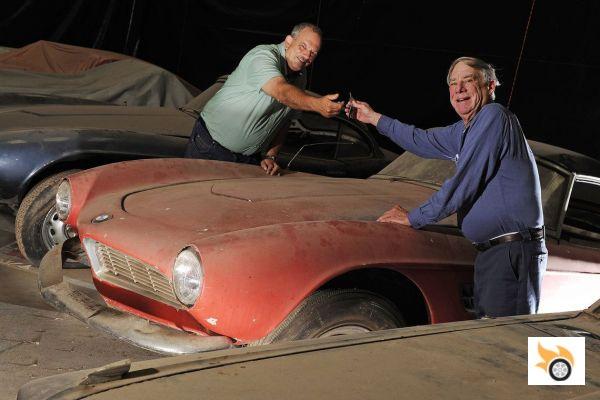
I speak in the past tense because this gentleman passed away in November 2014 at the age of 77. He never got to see his 507 Roadster restored again, but BMW made the dream he never got to fulfill come true: to see the car shine as it did of old. Had it not been for his contact with Bimmer magazine, this car would possibly have been lost forever, having been treated as mere scrap metal. Thanks also go to Mr. Castor for all the documentation he collected on the car, which allowed him to keep better track of it.
Rescuing the legend
BMW's classic division, having verified its authenticity, entered into negotiations with Jack Castor to acquire the car, although the retired engineer had no intention of cashing in on his prized possession. The car was in a sorry state and needed a lot of pampering. It was only a short time before its condition became so critical due to the advance of rust that it would be unrecoverable. In the spring of 2014 the car was shipped to Germany along with the spare parts Castor had amassed for it.
Thus, after more than 50 years in the United States, the 507 Roadster with chassis number #70079 returned to Munich. Before it was restored, and with all the punch it had accumulated after half a life standing in a barn, it was put on display for the press at the BMW Museum. It then underwent an extensive restoration process. The first difficulty was the lack of parts, even BMW is not guaranteed to have stocks for cars made 60 years ago. Some parts had to be made from scratch from the most modern techniques, such as 3D printing.
It was disassembled piece by piece. Although we are talking about a car from the 1950s, it already had an aluminium body mounted on a steel chassis. An acid bath was used to remove all traces of paint. BMW's aim was to leave the car as it left the factory, with the original number plate. The upholstery, for obvious reasons, was made completely new, although it could be accommodated in the original seat structure once the rust had been removed. Even a small set of rubber oil seals were produced for the fuel filler neck, so that part is once again available for the surviving 507s (and they are highly sought after today).
More complicated was restoring the engine, which was rebuilt from spare parts. BMW respected the original specification of the 4-series engines, with 150 bhp. It didn't get a new engine number as it's a bit of a Frankenstein, it has parts from several units. Part of the engine bay also had to be rebuilt, which had been altered to fit the considerably larger American V8 engine. As for the painting process, techniques from the 50's were used to give it a more authentic touch.
Now the car looks spectacular, just as it left the factory almost 59 years ago.
In 1954, the then importer of BMW in the United States, asked Germany to create a car that would be liked in the United States. Of course the engineers led by Albrecht Graf Goertz hit the nail on the head, this 507 Roadster was thrown in that country most of his life, and belonged to one of the most universal Americans of the twentieth century. That's what you call success, even if they made so few 507 Roadsters. It's a pity that the price ended up being double what was originally projected.
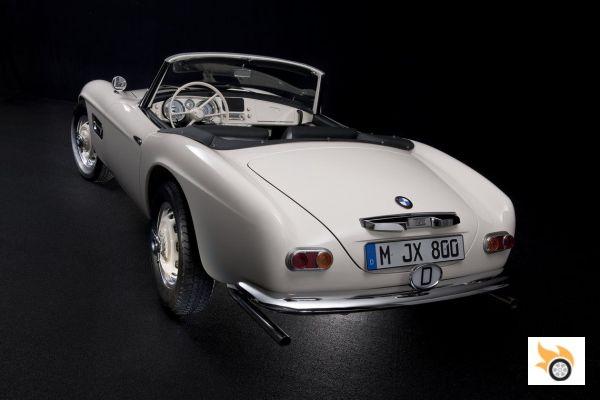
By the way, any keen eye will have noticed that the BMW Z8 is clearly inspired by this model... It's a legend for a reason.

























